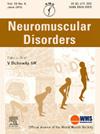The influence of genotype on the natural history of types 1 - 3 spinal muscular atrophy
IF 2.7
4区 医学
Q2 CLINICAL NEUROLOGY
引用次数: 0
Abstract
The severity of spinal muscular atrophy (SMA) is inversely correlated with the number of survival of motor neuron 2 (SMN2) copies an individual has. This observational, retrospective analysis of natural history data included untreated individuals with a genetic diagnosis of types 1–3 SMA and stratified disease-related characteristics by SMN2 copy number. The outcomes investigated were time to: death, permanent ventilation, respiratory support, feeding support, scoliosis surgery, and achievement and loss of motor milestones. Of 134 individuals; 33 had two SMN2 copies and 101 had 3 or more copies. Survival was linked to increasing SMN2 copy number: mean age at death for individuals with two SMN2 copies was 8 months (standard deviation [SD]: 4 months) and 10 years (SD: 5 months) for individuals with three copies, and no deaths were reported in individuals with ≥4 SMN2 copies. Increasing SMN2 copy number was linked to a longer time to permanent ventilation, respiratory support, feeding support, and scoliosis, as well as loss of motor milestones. SMA disease-related endpoints showed distinct patterns between groups with differing SMN2 copy numbers. Prediction and assessment of disease progression may be stratified by SMN2 copy number, which will be important for evaluating the impact of treatment.
基因型对1 ~ 3型脊髓性肌萎缩症自然史的影响。
脊髓性肌萎缩症(SMA)的严重程度与个体的运动神经元2 (SMN2)拷贝存活数量呈负相关。这项观察性、回顾性的自然病史数据分析包括未经治疗的个体,遗传诊断为1-3型SMA,并通过SMN2拷贝数分层疾病相关特征。调查的结果包括:死亡时间、永久性通气、呼吸支持、喂养支持、脊柱侧凸手术、运动里程碑的实现和丧失。134个个体;33人有2个SMN2副本,101人有3个或更多副本。生存与SMN2拷贝数的增加有关:携带两个SMN2拷贝的个体平均死亡年龄为8个月(标准差[SD]: 4个月),携带三个SMN2拷贝的个体平均死亡年龄为10年(SD: 5个月),携带≥4个SMN2拷贝的个体无死亡报告。SMN2拷贝数的增加与永久性通气、呼吸支持、喂养支持和脊柱侧凸的时间延长以及运动里程碑的丧失有关。SMA疾病相关终点在SMN2拷贝数不同的组之间显示出不同的模式。疾病进展的预测和评估可以通过SMN2拷贝数分层,这对于评估治疗效果很重要。
本文章由计算机程序翻译,如有差异,请以英文原文为准。
求助全文
约1分钟内获得全文
求助全文
来源期刊

Neuromuscular Disorders
医学-临床神经学
CiteScore
4.60
自引率
3.60%
发文量
543
审稿时长
53 days
期刊介绍:
This international, multidisciplinary journal covers all aspects of neuromuscular disorders in childhood and adult life (including the muscular dystrophies, spinal muscular atrophies, hereditary neuropathies, congenital myopathies, myasthenias, myotonic syndromes, metabolic myopathies and inflammatory myopathies).
The Editors welcome original articles from all areas of the field:
• Clinical aspects, such as new clinical entities, case studies of interest, treatment, management and rehabilitation (including biomechanics, orthotic design and surgery).
• Basic scientific studies of relevance to the clinical syndromes, including advances in the fields of molecular biology and genetics.
• Studies of animal models relevant to the human diseases.
The journal is aimed at a wide range of clinicians, pathologists, associated paramedical professionals and clinical and basic scientists with an interest in the study of neuromuscular disorders.
 求助内容:
求助内容: 应助结果提醒方式:
应助结果提醒方式:


